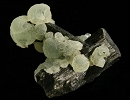
|
| Prehnite |
Chemical
Formula |
Ca2Al(AlSi3O10)(OH)2 |
Species |
Silicates |
Crystal
System |
Orthorhombic |
Mohs
Scale |
6 |
Specific
Gravity |
2.8-2.95 |
Color |
Colorless to gray to yellow, yellow-green or white |
Streak |
White |
Luster |
Vitreous, Pearly |
Refractive
Index |
n = 1.611 - 1.632 n = 1.615 - 1.642 n = 1.632 - 1.665 |
Diaphaneity |
Translucent |
Cleavage |
Distinct/GoodGood on , poor on |
Fracture |
Irregular/Uneven |
| Crystal Habit:Globular, reniform to stalactitic |
| Geological Setting:A secondary mineral in mafic volcanic rocks, low grade metamorphic mineral. |
Prehnite is a phyllosilicate of calcium and aluminium with the formula: Ca
2Al(AlSi
3O
10)(OH)
2. Limited Fe
3+ substitutes for aluminium in the structure. Prehnite crystallizes in the orthorhombic crystal system, and most oftens forms as stalactitic or botryoidal aggregates, with only just the crests of small crystals showing any faces, which are almost always curved or composite. Very rarely will it form distinct, well individualized crystals showing a square-like cross-section, like those found at the Jeffrey Mine in Asbestos, Quebec, Canada. It is brittle with an uneven fracture and a vitreous to pearly lustre. Its hardness is 6-6.5, its specific gravity is 2.80-2.90 and its color varies from light green to yellow, but also colorless, blue or white. In April 2000, a rare orange Prehnite was discovered at the famous Kalahari Manganese Fields in South Africa. It is mostly translucent, and rarely transparent.
Though not a zeolite, it is found associated with minerals such as datolite, calcite, apophyllite, stilbite, laumontite, heulandite etc. in veins and cavities of basaltic rocks, sometimes in granites, syenites, or gneisses. It is an indicator mineral of the prehnite-pumpellyite metamorphic facies. It is the first mineral to be named after someone, and was first described in 1789 for an occurrence in Haslach, Harzburg and Oberstein, Germany, and named for Colonel Hendrik Von Prehn (1733–1785), commander of the military forces of the Dutch colony at the Cape of Good Hope from 1768 to 1780. Extensive deposits of gem quality Prehnite occur in the basalt tableland surrounding Wave Hill Station in the central Northern Territory, of Australia.
Gallery


 YueGongAnBei 44051102000467
YueGongAnBei 44051102000467


 |
|